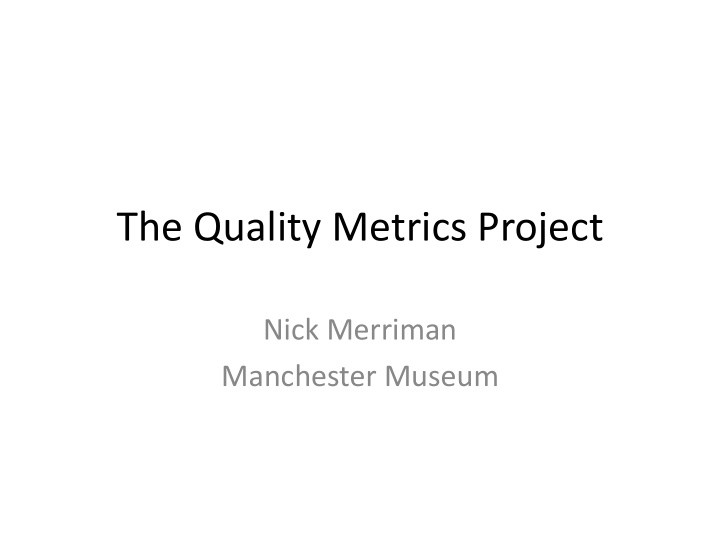



The Quality Metrics Project Nick Merriman Manchester Museum
Measuring quality & reach in arts • Western Australian example • ACE invited consortium of Manchester organisations to work with Intelligence Agency to explore potential of an English metrics system • Started from first principles: how do we measure quality & reach in a way that is useful and credible for the sector? • Working group of 12 senior people from arts organisations in Greater Manchester • Series of workshops scoping out what a framework might look like
2 main categories; range of dimensions Quality Organisational Health • Excellence: measured • Financial metrics through a dashboard of 9 • Quality of cultural indicators, e.g. leadership – Quality of product • Quality of relationships & – Quality of experience partnerships – Quality & depth of engagement – Quality of creative process
How do we measure? • Triangulation of evaluation by self, peers and public • Using a common app • 9 dimensions evaluated by all 3 groups • 5 extra dimensions evaluated by self and peers
Intrinsic dimensions (self, peer, public) Dimension Metric Statement Rigour ‘It was well thought through and put together’ Distinctiveness ‘It was different from things I’ve experienced before’ Captivation ‘It was absorbing and held my attention’ Relevance ‘It has something to say about the world in which we live’ Meaning ‘It meant something to me personally’ Challenge ‘It was thought provoking’ Enthusiasm ‘I would come to something like this again’ Presentation ‘It was well produced and presented’ Local impact ‘It is important that it’s happening here’
Intrinsic dimensions ( self & peer only ) Dimension Metric Statement Concept ‘It was an interesting idea / programme ’ Orginality ‘It was ground - breaking’ Risk ‘The artists / curators really challenged themselves with this work’ Excellence ‘It is amongst the best of its type in the world’ (global) Excellence ‘It is amongst the best of its type in the UK’ (national)
Instrumental dimensions • Intrinsic impact data from artists, peers and the public to be combined with traditional instrumental data on attendances, box office, earned income (including sponsorship and philanthropic), funded income • Future plans to integrate secondary demographics of audiences and communities of interest
The Pilot • Selected 8 events (ticketed and non-ticketed) in Manchester & Cumbria eg: – The Day We Sang (Royal Exchange) – Robin Hood (Octagon Bolton) – Advent Avenue (Contact Theatre) – Jeremy Deller (Manchester Art Gallery) – Verdi Bicentenary Concert (Halle orchestra) • Each organisation selected 3-5 peers (local & national) • Peers asked to evaluate before the show/exhibition & after • Trained individuals in each of the venues to administer the test • Administered on an app on tablet computers • Analysed the results & draft report
The app
Average peer before & after scores: Halle Verdi bicentenary concert
Halle: Average self, peer and public scores for Verdi Bicentenary Concert
Contact: Average self, peer and public scores for CYAC: Advent Avenue
Octogon Bolton: Average self, peer and public scores for Robin Hood
Average self, peer & public scores for Manchester Museum vivarium redisplay
Lessons learned • Not all of the dimensions work well: Presentation, Rigour, Captivation & Enthusiasm seems to be measuring same thing: ‘was it a good night out?’ • Need to add context: e.g. a free text box • Organisations should say what kind of scores they would be aiming for (e.g. international excellence?) • Time series data essential: aim for balance across year • Issues around training & administration of app • People really liked to engage with it: wanted to talk • Questions need refinement
Potential: What it is and what it isn’t • It is NOT – A replacement for KPIs – A replacement for qualitative evaluation • It could offer potential of a framework for measuring public value that: – Has the support of the sector – Measures what we want to measure – Provides time-series data for individual organisations – Can be aggregated at different scales, including nationally – Is credible with funders and other stakeholders
Next steps • Refine the questions • Add in instrumental/organisational health aspects • Need to develop time-series data: look at a balanced artistic portfolio • Expand the range of art forms and localities • Examine what the back office, big data implications are • Waiting for outcome of NESTA Digital R&D Fund bid
Recommend
More recommend